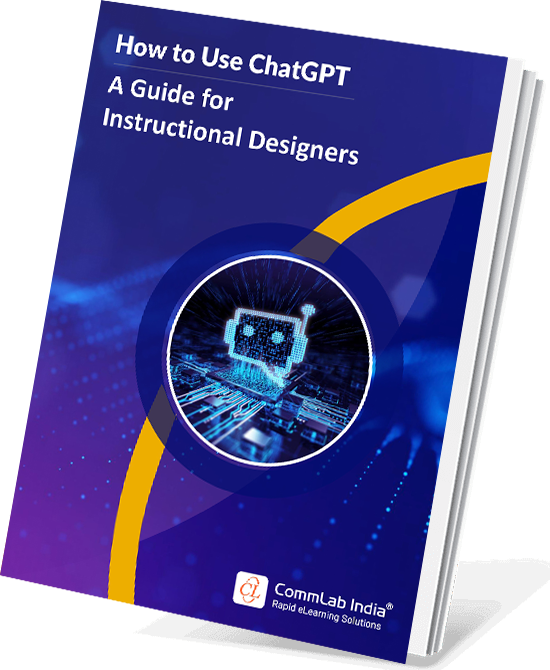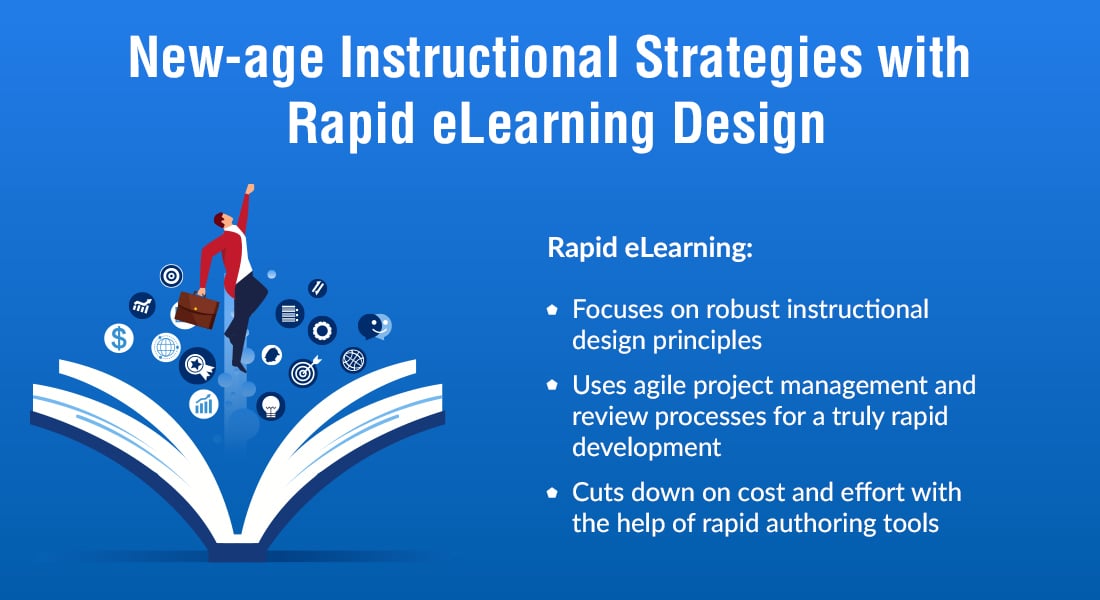6 Instructional Design Strategies for Engaging Rapid eLearning Courses

In the current business environment, rapid eLearning design and development is becoming increasingly important. Considering the scalability and flexibility that the approach brings with it, learning and development teams and instructional designers have to adopt it quickly so that they can effectively adapt to the ever-changing environments.
Are you an instructional designer (ID)? Then this blog is for you. In this blog post, we will discuss 6 essential instructional design strategies or ID strategies that can help you improve your online training’s effectiveness while enabling rapid eLearning design.
→ Download eBook: Instructional Design — Unleashing the Power of ChatGPT
Table of Contents
- How to Design Engaging Rapid eLearning Courses?
- Gamification
- Storytelling
- Microlearning
- Audio/Video Interactions
- Performance Support Tools
- Social Learning Replication and Collaboration Feature
How to Design Engaging Rapid eLearning Courses — 6 ID Strategies to Follow
Want to Make Your Rapid eLearning Courses More Engaging?
Include These Instructional Design Strategies in Your eLearning Solutions:- Gamification
- Storytelling
- Microlearning
- Audio/Video Interactions
- Performance Support Tools
- Social Learning Replication and Collaboration Feature
1. Gamification
Gamification in eLearning is a great way to add excitement and engagement to your eLearning course. By adding game-like elements, you can make learning more fun and interactive for your learners. Here are some tips on how to Gamify your eLearning courses:
Add points, badges, and leaderboards
Adding points, badges, and leaderboards is a great way to gamify your eLearning course. These elements will encourage learners to compete with each other and strive to achieve the highest score. You can also offer rewards for those who reach the top of the leaderboard.
Use game-based activities
Another way to gamify your eLearning course is by using game-based activities. This could involve incorporating quizzes, puzzles, or other challenges into your course. Learners can work through these activities at their own pace and see their progress as they go.
Create a story or plotline
If you want to really capture your learner’s attention, try creating a story or plotline for them to follow along with. This can make the learning experience more enjoyable and immersive for learners. You can even include branching scenarios so that learners can make choices that affect the outcome of the story.

Watch our gamified sample course in action!
2. Storytelling
Good stories do more than create a sense of connection. They build familiarity and trust and allow the listener to enter the story where they are, making them more open to learning.
Source: Harvard Business Publishing
Storytelling can be a powerful instructional design strategy for engaging learners and helping them to connect with and remember new information. When used effectively, stories can help learners make sense of complex concepts, see different perspectives, and visualize what is being learned.

When designing custom eLearning courses, consider incorporating stories into your content in various ways. For example, you could use stories to:
- Introduce new topics or review key points from previous modules
- Help learners understand complicated processes or procedures
- Describe real-world applications of the concept being discussed
- Provide examples of common misconceptions or pitfalls to avoid
- Encourage reflection and critical thinking about the training being delivered
3. Microlearning
Microlearning is a term used to describe a learning strategy that delivers content in short, manageable bursts. This approach is designed to help learners absorb and retain information more effectively by providing them with bite-sized pieces that they can digest and assimilate more easily.
When applied to rapid eLearning design, microlearning can be an effective way to quickly adapt your training modules to meet the needs of your learners. By breaking down your content into small, manageable chunks, you can deliver your rapid eLearning course more efficiently and help your learners focus on the most important information.
There are a number of different ways you can incorporate microlearning into your custom eLearning design. For example, you could use short video segments or create interactive quizzes that test learners’ knowledge as they progress through the course. Additionally, you can use microlearning solutions to provide just-in-time learning opportunities for learners who need extra support or reinforcement.
No matter how you choose to integrate microlearning into your eLearning design, this instructional design strategy can help you deliver rapid eLearning courses that are both effective and engaging for your learners.

4. Audio/Video Interactions
In order to engage learners in your rapid eLearning design, consider using audio and video interactions. This can include adding voice-overs to slideshows or screenshots, recording videos of trainers or SMEs giving demonstrations, or incorporating interactive videos that learners can control. You can also add captions to explain complex concepts or terminology.
When using audio and video interactions in your rapid eLearning solutions, it is important to keep the following in mind:
- Use clear and concise language
- Avoid technical jargon
- Keep videos short (under 5 minutes)
- Make sure visuals are high quality
- Pay attention to sound quality

How to Use ChatGPT — A Guide for Instructional Designers
Create Immersive Learning Experiences by leveraging ChatGPT
- Frame Learning Objectives
- Generate Scenarios
- Design Assessments
- And More!
5. Performance Support Tools
Performance support tools are designed to help learners perform a specific task or complete a specific goal. They can be used independently or in conjunction with other instructional design strategies.
Watch this video to take a sneak peek into the what and why of performance support tools.
Performance support tools can take many different forms, but they all share one common goal: to provide just-in-time support that allows learners to achieve their objectives. Some examples of performance support tools include job aids, cheat sheets, quick reference guides, and how-to videos.
When selecting performance support tools for your rapid eLearning course, consider the following:
- How will the tool be used?
- Will the learner need access to the tool during or after the course?
- What format will be most accessible and user-friendly for the learner?
- Is the tool reusable and adaptable for future courses?
With these considerations in mind, let’s take a closer look at some of the most popular performance support tools:
Job Aids
A job aid is a tool that provides step-by-step instructions for completing a task or goal. Job aids can be in any format, including text, images, video, or audio. They should be concise and easy to use so that learners can quickly find the information they need and put it into action.
Cheat Sheets
A cheat sheet is a type of job aid that provides key information about a skill or task. Cheat sheets are typically very short and contain easy-to-read bullets or other visuals. They can be used alone or as part of a larger learning package.
Quick Reference Guides
A quick reference guide is a more comprehensive type of job aid that provides detailed information on how to complete a task. They usually contain more detailed text and images than cheat sheets, but they are still designed to be used quickly and easily.
How-To Videos
How-to videos are an effective way to provide self-paced, visual instruction on how to complete a task. They offer the advantage of providing learners with both text and audio instructions, so they can easily follow along without having to read every step. How-to videos can also be reused in multiple courses, making them a cost-effective option for rapid eLearning courses.
6. Social Learning Replication and Collaboration Feature
Organizations are always looking for ways to save time and money while still providing quality training to their employees. One way to do this is by using instructional design strategies that can be quickly adapted to new situations.
One such strategy is social learning, which can be used to replicate and share information among a group of learners. This type of eLearning is especially effective in today’s fast-paced world, where information is constantly changing and new technologies are being introduced all the time.
Social learning can take many different forms, but one of the most common is peer-to-peer learning. In this type of learning, learners work together to complete a task or solve a problem. This approach has many benefits, including the fact that it can help learners retain information better than if they were working alone.
Another common form of social learning is collaborative learning. In this approach, learners work together in small groups to complete a task or project. This type of learning has been shown to be particularly effective in developing critical thinking and problem-solving skills.
Finally, social media can also be used as a tool for social learning. Platforms like Facebook, Twitter, and LinkedIn provide an easy way for learners to connect with each other and share information. This makes it a perfect strategy to be included in rapid eLearning projects.
Discover practical tips to enhance social learning and foster collaboration in your corporate training programs!
Wrapping Up
Rapid eLearning can be a great solution for organizations that need to develop training content quickly, but it’s important to keep in mind to choose the right instructional design strategies suitable for rapid eLearning design. Hope the article has helped you understand some new-age strategies that you should adopt in order to make your eLearning projects more engaging.
Like every other sphere, AI is making its way into instructional design too. This modern technology is helping instructional designers design courses faster and with more creativity. ChatGPT — the popular AI tool is revolutionizing the world of instructional design. Get your hands on this eBook for actionable insights.





![Top 3 Instructional Design Strategies That Pair Perfectly with Rapid eLearning [SlideShare]](https://blog.commlabindia.com/hubfs/Imported_Blog_Media/instructional-design-strategies-rapid-elearning-slideshare.png)
